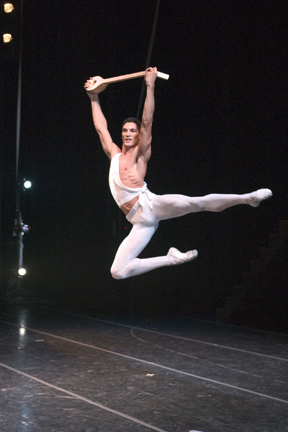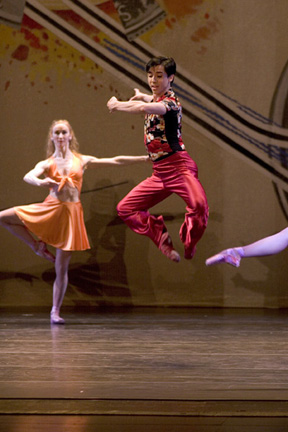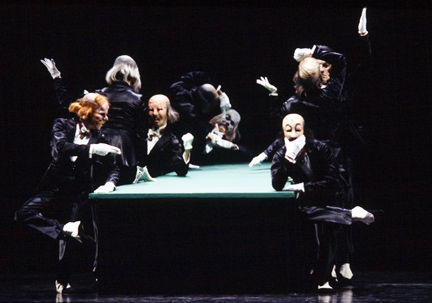Joffrey's Golden Oldies
“Apollo”, “Deuce Coupe”, “The Green Table”
Joffrey Ballet of Chicago
Tilles Center for the Performing Arts, C.W. Post University
Brookville, NY
March 9, 2007
copyright ©2007, Susan Reiter
 Once upon a time the Joffrey Ballet was a New York City mainstay. Back in the full flush of the dance boom, the company would perform two substantial seasons (spring and fall) annually at City Center. These days, after a somewhat shaky period that followed soon after Robert Joffrey’s death in 1988, they have found a supportive home base in Chicago. But New Yorkers have seen little of them aside from their participation in shared Ashton programs presented by the 2004 Lincoln Center Festival, so a full evening repertory performance an hour outside the city was a definite must-see, and proved to be a substantial, impressive evening.
Once upon a time the Joffrey Ballet was a New York City mainstay. Back in the full flush of the dance boom, the company would perform two substantial seasons (spring and fall) annually at City Center. These days, after a somewhat shaky period that followed soon after Robert Joffrey’s death in 1988, they have found a supportive home base in Chicago. But New Yorkers have seen little of them aside from their participation in shared Ashton programs presented by the 2004 Lincoln Center Festival, so a full evening repertory performance an hour outside the city was a definite must-see, and proved to be a substantial, impressive evening.
The program included two works that helped define the Joffrey’s profile and were repertory mainstays at City Center — Kurt Jooss’ “The Green Table” and Twyla Tharp’s “Deuce Coupe.” It opened with Balanchine’s “Apollo,” which the company first performed in 2004. The staging of this production, which included the birth scene and wasperformed to taped music, was puzzlingly credited to Mark Goldweber, a leading Joffrey dancer who is now a ballet master. It would seem that someone with more of a direct and longstanding Balanchine connection would have set the work initially, before it was turned over to the in-house team.*
 Fabrice Calmels, in the title role, displayed an engaging blend of muscular vigor and classical elegance. He is on the tall side, and well proportioned, with long legs. He gave an eager, unmannered performance of this touchstone role but it still had a learned quality rather than displaying an individual stamp. He had a tendency to smile gleefully at moments when a more sober mien would have been preferable. In his second solo, Calmels was still performing more on the surface of the movement; his needs to delve into its more grounded movements with weightier authority, and imbue the choreography with the drive and energy that tell us Apollo is summoning up the full strength of his godly powers.
Fabrice Calmels, in the title role, displayed an engaging blend of muscular vigor and classical elegance. He is on the tall side, and well proportioned, with long legs. He gave an eager, unmannered performance of this touchstone role but it still had a learned quality rather than displaying an individual stamp. He had a tendency to smile gleefully at moments when a more sober mien would have been preferable. In his second solo, Calmels was still performing more on the surface of the movement; his needs to delve into its more grounded movements with weightier authority, and imbue the choreography with the drive and energy that tell us Apollo is summoning up the full strength of his godly powers.
Among the muses, Valerie Robin as Polyhymnia made a striking and memorable impression. Rather tall, with dark hair, she has the bracing boldness of attack that allows her to make the movement her own. The challenging diagonal of turns in her solo was fearlessly and powerfully delivered; this is not a dancer who holds back. April Daly’s Calliope was restrained and muted. In her solo, she did not get inside the music to the fullest possible extent, and what was saw felt more cautious than authoritative. As Terpsichore, Kathleen Thielhelm displayed lyrical fragility but her dancing was always strongly centered. Somewhat lacking was the incandescence that should draw Apollo to select her above the others.
Robin was also magnificent throughout “Deuce Coupe,” in which many of the dancers really dug in and captured the work’s original spirit of youthful freshness, having a blast while keeping things taut and sharply focused. While this landmark Tharp work cannot, 34 years later, hit the stage like the exclamation point of innovation that it was at its premiere, it remains both a terrific vehicle for performers and an early, already quite sophisticated, indication of how Tharp was reinvigorating the concept of ballet virtuosity, challenging the dancers to rev up their classical technique while engaging their backs and torsos and allowing them to be freer and more spontaneous. She asked them to loosen up their brains as well as their bodies.
Staged by William Whitener, this version — closely based on “Deuce Coupe III,” the version Tharp’s own company performed in the early 1980s, incorporating elements from the original (performed by a large Joffrey cast as well as Tharp herself and five of her dancers) and the second version designed for Joffrey dancers only. There was no backdrop on this occasion, though the program listed “scenic design by James Rosenquist.”
 While the all-important central ballerina in white, wending her pristine, focused way through a lexicon of classical steps amid the hot colors and free-spirited activity around her, is very much still important to the work, she vanishes for a very long stretch of time about one-third of the way through, so the searing determination, the almost moral force, of her ongoing, consistent process is somewhat muted. Heather Aagard, attacked her steps with lyrical buoyancy. She was separate but not all that far removed from the others, displaying her own brio and a hint of playfulness.
While the all-important central ballerina in white, wending her pristine, focused way through a lexicon of classical steps amid the hot colors and free-spirited activity around her, is very much still important to the work, she vanishes for a very long stretch of time about one-third of the way through, so the searing determination, the almost moral force, of her ongoing, consistent process is somewhat muted. Heather Aagard, attacked her steps with lyrical buoyancy. She was separate but not all that far removed from the others, displaying her own brio and a hint of playfulness.
Julianne Kepley did impressive, versatile multiple duty as both the center of the witty, punchy trio slip-sliding their way across at the front of the stage in “Take a Load off Your Feet” and then coming right back as bounce around in “Long Tall Texan” with a cheekily bow-legged Brian McSween. She then oozed and preened delectably through the ultra-sensual “Got to Know the Woman” solo, defining and yet gently mocking the cliché of female “come-hither” display.
Seeing “Deuce Coupe” again now reconfirms how, as early as 1973, Tharp was already giving male ballet dancers new horizons in virtuosity to explore, harnessing their multiple pirouettes and elegant line, extending their lyrical possibilities and also challenging them with feats that demand speed and brilliant articulation. It was through her Joffrey association that dancers like Whitener and Richard Colton came to join her company and anchor the incredible male roster she had from the late 1970s well into the ‘80s.
Mainly remembered as an exuberant blast of fresh air harnessing the touchstone Beach Boys music, Deuce Coupe reveals itself now as a work that strikes a lovely balance between witty playfulness and wistful reflection. The Matrix sections Tharp threads between the songs (expansive piano variations based on the final Beach Boys song, the yearningly romantic “Cuddle Up”) provide part of this balance, and the bittersweet finale, with its images of a community both enjoying mutual support but also fragmenting, makes it seem like the carefree days of surfing, pot-smoking are being left behind.
 The Joffrey is the company that introduced “The Green Table” to a new generation, with its 1967 production, overseen by Jooss himself, that became a longstanding repertory staple. For the past two years, New York audiences have again been able to experience this potent — and unfortunately still all-too-relevant — expressionist examination of war in ABT’s production. But from this performance, it is clear that the Joffrey still can claim a special insight into this work. They sustained its power and struck just the right note throughout. The company can also field an exceptional interpreter, John Gluckman, of the pivotal role of the Profiteer, a role that has not yet achieved its full power in ABT’s performances. The Profiteer has the last word, so to speak, in scene after scene, Gluckman perfectly captured the character’s slippery opportunism and deft, almost vaudevillean movement quality. Many in the audience were clearly experiencing “The Green Table” for the first time (the Gentlemen in Black’s firing of their guns met with nervous laughter), and one could sense the recognition of the work’s timeless insight and brilliant encapsulation of dark truths that unfortunately never go out of style.
The Joffrey is the company that introduced “The Green Table” to a new generation, with its 1967 production, overseen by Jooss himself, that became a longstanding repertory staple. For the past two years, New York audiences have again been able to experience this potent — and unfortunately still all-too-relevant — expressionist examination of war in ABT’s production. But from this performance, it is clear that the Joffrey still can claim a special insight into this work. They sustained its power and struck just the right note throughout. The company can also field an exceptional interpreter, John Gluckman, of the pivotal role of the Profiteer, a role that has not yet achieved its full power in ABT’s performances. The Profiteer has the last word, so to speak, in scene after scene, Gluckman perfectly captured the character’s slippery opportunism and deft, almost vaudevillean movement quality. Many in the audience were clearly experiencing “The Green Table” for the first time (the Gentlemen in Black’s firing of their guns met with nervous laughter), and one could sense the recognition of the work’s timeless insight and brilliant encapsulation of dark truths that unfortunately never go out of style.
* According toi the Balanchine Trust, "Apollo" was staged by Paul Boos. Mark Goldweber has "maintained" the work since the 2004 premiere,
Volume 5, No. 10
March 12, 2007
copyright ©2007 by Susan Reiter
www.danceviewtimes.com